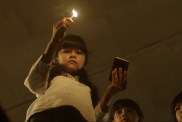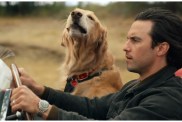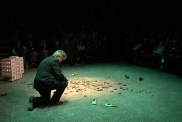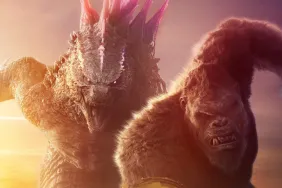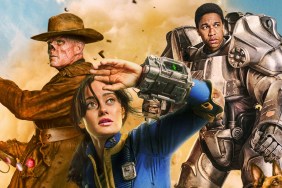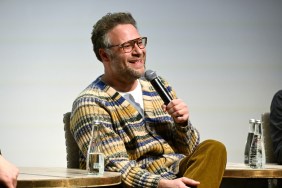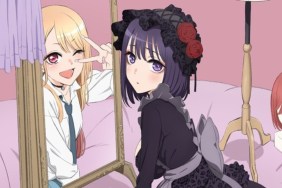
One of the many joys of being a parent, an aunt, or an uncle is passing on your biggest fandoms. For those who love horror, its all about that day when youre finally able to show your son, daughter, niece, or nephew the movies that both scared you silly and inspired your lifelong passion for horror as youngsters. More often than not, itll be films like Frankenstein, The Creature from the Black Lagoon, The Wolf Man, and The Blob.
What all of those films have in common is the convergence of fantasy into realitythough their genre merits are legend and their scares are legit, theyre gateway horror movies. Everything in The Creature from the Black Lagoon, for example, is real except for the scaly humanoid that lives beneath the water. The titular Creature is the quintessential movie monster: something thats inhuman, nightmarish-looking, but also sympathetic enough to tap into even the oldest viewers inner tyke. After all, the fish-like ghoul just wants to love the stunning Julia Adams. Thats much easier for kids to embrace than, say, Henry: Portrait of a Serial Killer, The Shining, or The Exorcist, all of which are cerebral and, lets face it, far less pleasant than any made-up boogeymen establishing residence in childrens closets.
But wheres the new Creature from the Black Lagoon? The sad truth is, kids arent currently able to experience that similar kind of monster discovery on their own. Theyre growing up in a climate where horror cinema seems to have forgotten all about ingenuity for the unrealistic. As they get older, todays budding horror consumers will rush off to multiplexes to watch, bless their poor souls, the rebooted Universal Monsters moonlighting as wannabe Marvel action heroes, or Poltergeist 2: The Other Versions Unnecessary Sequel, or Found-Footage Possession Movie No. 75. You have to feel for themtheyve been helplessly born into a time period where studio horrors stuck in a deep rut filled with one familiar trope after another. Even the good examples of modern monster flicks are déjà vu generators. Last years Godzilla was a winner, but its still another Godzilla, while Adrian Garcia Boglianos strong werewolf film Late Phases is simply that, a strong werewolf film, not a film that does anything new with the lyncathrope sub-genre. With its undeniably gnarly practical effects, Boglianos film is indebted to An American Werewolf in London rather than being an bold extension of John Landis 1981 classic.
Dont sign the modern movie monsters R.I.P. Creativity death certificate just yet, however. This weekend, Hatchet franchise mastermind Adam Green returns with his latest film, Digging Up the Marrow, a faux documentary thats fully embedded in the love of the progressive monster culture. Green stars as himself and tracks down a man named William Dekker (played by Ray Wise), a possibly delusional elder who claims to have seen real-life monsters and know where they all reside: inside an underground world he dubs the Marrow, and whose entrance lies in a desolate cemetery on the outskirts of Southern California. Being that Digging Up the Marrow is a horror movie, of course, Green does eventually meet some of these monsters, andall designed by acclaimed artist Alex Pardeetheyre altogether grotesque and, most importantly, wholly original. Theres Vance, a hulking humanoid whose facial-covering sack also hides multiple appendages and deformities; Brella, an alluring beast with a womans physique and a large umbrella concealing its hideous head; and Chicken, a little bugger that skirts across the ground and combines the features of a spider and the headliner in Frank Henenlotters Basket Case.
Theres just something so enjoyably invigorating about Marrows monsters. Its just a matter of keeping the imagination alive, says Pardee. Whenever I see something new, I always say to myself, Wow, if that looks like this, maybe theres something else out there that looks like that! But thats not generally other peoples approach. Whenever somebody decides to remake something like The Fly again or redo The Mummy, why not just think about it a little more and put even a slight creative spin on it? That way, you can make it a whole new thing, which can then evolve. Its all about evolutionwe wouldnt have the monsters we have now if it werent for the monsters that were created originally.
Digging Up the Marrows monsters all come directly from Pardees terrifically warped mind, itself the product of what came before. The Cali natives love for all things monstrous stems back to the night when, as a 13-year-old, he snuck downstairs to infiltrate his older sisters slumber party while they watched Poltergeist and Creepshow on VHS, which then led to his father buying him back issues of EC Comics Tales from the Crypt. Those influences inform Marrows wild ones. Ive always been fascinated with shapes and breaking down those shapes into silhouettes Ive never seen before, says Pardee. That goes as far back as grade school, when I was more attracted to a deflated ball rather than inflated ball. Whenever Im doing art or design work, its a matter of sketching different shapes and then filling in those shapes. While Im scribbling, something will click and Ill say, Okay, this needs to have something spider-ish, and Ill start pulling in inspirations around that.

That playfulness is felt throughout Digging Up the Marrow. Greens self-made and self-financed passion project is just as much of a pro-monster celebration as Joss Whedon and Drew Goddards The Cabin in the Woods, which Pardee cites as a direct inspiration. Like Cabin, Digging Up the Marrow reminds horror fans that, yes, they did once bask in the wonders of frightening aberrations that theyd never seen before. Its a love letter to the days of Rick Baker and Stan Winston, a ride back to the 1980s and the magic of seeing nearly indescribable, what-the-hell-is-that creations like Ghoulies and Pumpkinhead, or the joys of reading stories by H.P. Lovecraft and Clive Barker for the first time. Although its played more for laughs than white-knuckle scares, Digging Up the Marrows DNA is the essence of old-school horror. [Marrow] is the type of movie that a studio would never make now, says Green. Theyd never make something with original monsters anymore, which is a shame.
Greens affinity for conceiving original monsters isnt newhis career has been defined by that characteristic. Aside from its throwback slasher roots, the first Hatchet movie is engrained with the same kind of freshness as Digging Up the Marrow. Its antagonist, Victor Crowley, is a disfigured supernatural brute thats equal parts Frankensteins monster and a ghostly riff on Madmans Madman Marz. Victor Crowley is a very sympathetic character, explains Green. He didnt ask to become a killer; its a tragic situation that he was born this way, and now hes a ghost who died tragically and is lashing out. Because of that, Hatchet gave me faith that there were other horror fans like me who wanted a new monster.
In the 80s we had so many of them, continues Green, but in the 90s it became all teen whodunit things because Scream was so good and then studios produced so many knockoffs of it. When I created Hatchet in the 2000s, it was really my answer to the torture porn thing. I didnt fall in love with the genre because I wanted to watch women get raped or strapped to a chair, tortured, and forced to beg for her lifethats not a good time for me. I dont believe in punishing the audience; you shouldnt leave a movie and feel like your eyes just got raped. We just tried to bring the fun back, and people responded in ways we never anticipated. I dont know if Marrow would have happened without the response Hatchet received.
The film also wouldve never come to fruition if not for Greens decision to steer clear of studios and high-profile distribution companies. Imagine a bigger-budget version of Digging Up the Marrow, as much of a pipe dream as that soundsinstead of Greens films practical effects and monsters that can actually touch the human characters, youd most likely get digital creatures thatd look dated as soon as 2016. As it stands, Marrow features handcrafted monsters thatll look just as cool ten years from now as they do today.
Thats all by design. As genre fans, I think were incredibly misunderstood by Hollywood, says Green. I dont think theyll ever really figure out what it is that we like. When you look at some of the biggest successes, theyre all independent movies. Of course, when you look at, say, The Exorcist, that was a studio movie, and how that ever happened, Ill never know. But if you look at Halloween, Evil Dead, Friday the 13th, A Nightmare on Elm Street, The Blair Witch Project, Paranormal Activity, or even Saw, theyre all independent movies. A studio never wouldve understood those, but then once they performed, the studios then jump in and try to do their versions of it, but they dont understand that we know when were looking at a cartoon, and that takes us out of it. Wed rather have practical effects.
Green and Pardee are currently touring throughout the country with Digging Up the Marrow, pairing the film itself with a mini exhibit of Pardees original sketches and prints available for purchase. Theyre on a two-man mission to promote their shared love of monsters, and, sadly, from a filmmakers perspective, theyre mostly alone in that. This years horror horizon looks great, with gems like It Follows and Unfriended nearing their debuts, but 2015 is barren in terms of its Creature from the Black Lagoon disciples. Digging Up the Marrow notwithstanding, monsters arent the premium. Our genre is always reflecting the times, says Green. Thats why torture porn happened, and thats why it was important; we were in an age when we were watching journalists get beheaded on TV, worrying that terrorism that could come home and that we werent invincible. Then you go back to Night of the Living Dead and the reactions to Vietnam. The genre is a mirror that shows you a different reality thats even more terrifying, but its also been built on ingenuity, ideas, and pushing the envelope, down to all the great makeup effects artists weve had and all of the monsters that we loved as kids.
And hopefully, this generations kids will somehow get to experience that for themselves. An audiences imagination should never be taken for granted, says Green. Horror cant always be mean-spirited; it cant always be fire-and-brimstone; it cant always be sad. Thats why monsters are so importantthey make you happy, they fuel the imagination, and they make you think. Why cant fantasy be a part of reality? Maybe people would be a little bit happier.
—
Matt Barone is a film-obsessed writer who, when hes not contributing to outlets like Complex, The Dissolve, and Badass Digest, endlessly weighs in on all things horror on Twitter.
